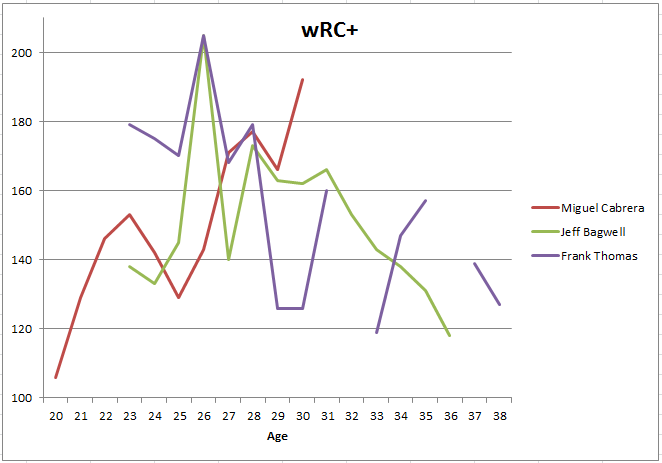The following chart is taken from the Hardball Times by Mitchel Lichtman in a 2009 article. It shows the normal aging curve of MLB players:
The chart shows that most players have their best seasons around age 26-29 and then start their decline. Cabrera is going to have his age-31 season in 2014.
Using the tools at FanGraphs, I filtered the table to show who had reached 190 wRC+ over the last 30 years. Only six other players have done it along with Cabrera: Barry Bonds, Jeff Bagwell, Frank Thomas, Mark McGwire and Jason Giambi. Out of those names, only Bonds and McGwire had their 190+ wRC+ seasons after the age of 30. Both (along with Giambi) have been linked to steroids, so their numbers could be misleading.
The two "clean" players, Thomas and Bagwell both had their best season when they were 26, both in 1994 with the same 205 wRC+ (and both won MVPs that season). Here is how Cabrera compares with them, using wRC+:
| Age | Miguel Cabrera | Jeff Bagwell | Frank Thomas |
|---|---|---|---|
20
|
106
|
||
21
|
129
|
||
22
|
146
|
||
23
|
153
|
138
|
179
|
24
|
142
|
133
|
175
|
25
|
129
|
145
|
170
|
26
|
143
|
205
|
205
|
27
|
171
|
140
|
168
|
28
|
177
|
173
|
179
|
29
|
166
|
163
|
126
|
30
|
192
|
162
|
126
|
31
|
166
|
160
|
|
32
|
153
|
||
33
|
143
|
119
|
|
34
|
138
|
147
|
|
35
|
131
|
157
|
|
36
|
118
|
||
37
|
139
|
||
38
|
127
|
And in chart form:

I eliminated all the years that didn't have large enough PA samples. Now, this isn't a perfect comparison. Bagwell and Thomas didn't have their first full years until they were 23, while Cabrera was 20. Bagwell and Thomas also had their peak seasons four years younger than Cabrera was in 2013. It could be possible that Cabrera won't age the same way and he'll have another season just as good or even better than 2013. However, that would be a very unique case for someone that hasn't been linked to steroids in recent years.
There are also other factors, such as his groin injury and lineup protection (if you believe that sort of thing exists). This also isn't to say that Cabrera won't have another great season. Even if he regresses back to his 2010-2012 levels, that's still MVP-worthy. The question still remains, though, will he have another year as great as his 2013 season? The answer is probably not.
This is just something to think about as I'm preparing for my 2014 predictions.
This is just something to think about as I'm preparing for my 2014 predictions.

